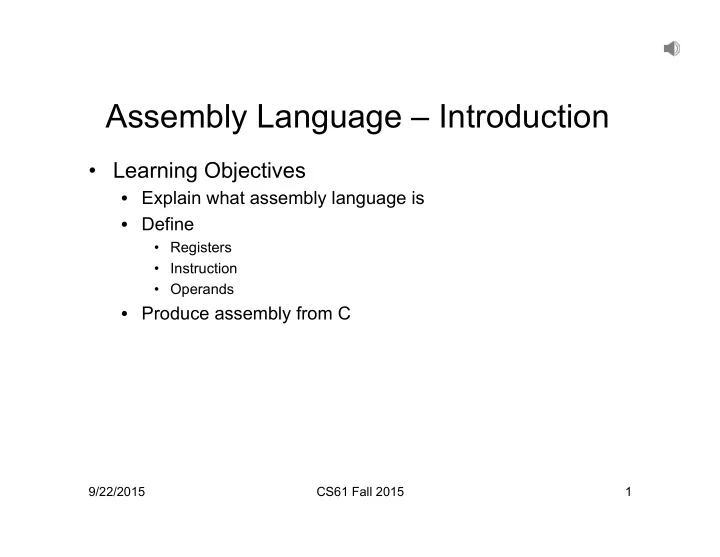

Assembly Language – Introduction • Learning Objectives • Explain what assembly language is • Define • Registers • Instruction • Operands • Produce assembly from C 9/22/2015 CS61 Fall 2015 1
What is assembly? • Yet another layer of abstraction! • When you strip away C, the assembly language is a human readable representation that more closely matches the hardware. • Typically each assembly instruction corresponds to a machine instruction. • Assembly doesn’t really manipulate variables; it expresses computation in terms of: • Registers • Memory • Instructions 9/22/2015 CS61 Fall 2015 2
A Note on our Assembly • We are using Intel x86 assembly and assuming a 32- bit processor. • The 3 rd edition of the book uses a 64-bit architecture in most sections, but still has some remnants of the 32-bit architecture as well. • The two are quite similar, but keep in mind that we’re using 32 bits. • Three ways to see assembly output: • cc –S –O3 x.c • objdump –d x.o • In gdb: disassemble <address> 9/22/2015 CS61 Fall 2015 3
Screen Capture 9/22/2015 CS61 Fall 2015 4
Example .file "1.c" .text .globl func .align 16, 0x90 .type func,@function func: # @func # BB#0: ret .Ltmp0: .size func, .Ltmp0-func .ident "Ubuntu clang version 3.4-1ubuntu3 …" .section ".note.GNU-stack","",@progbits 9/22/2015 CS61 Fall 2015 5
Registers • Registers are fast memory in the processor. • Processors typically execute most instructions in a single cycle; accessing memory can take 10’s or 100’s of cycles; placing data in registers allows the processor to execute things more quickly. • Most processors have a few tens of registers. • The Intel x86 has eight 32-bit registers: • %eax, %ebx, %ecx, %edx, %edi, %esi, %esp, %ebp • There are conventions for how some of the registers are used. • For example: %esp is the stack pointer • %ax is the lower 16 bits of register %eax • %al is the low order byte of register %eax • %ah is the second lowest order byte of %eax 9/22/2015 CS61 Fall 2015 6
Kinds of instructions • Move data around • Perform arithmetic operations • Perform logical operations • Compare things (sets condition flags) • Flow control 9/22/2015 CS61 Fall 2015 7
Recommend
More recommend